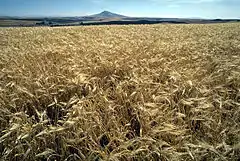Rabi crop
Rabi crops or rabi harvest are agricultural crops that are sown in winter and harvested in the spring in India[1] and Pakistan. The term is derived from the Arabic word for "spring", which is used in the Indian subcontinent, where it is the spring harvest (also known as the "winter crop"). The opposite of the rabi crop is the kharif crop which is grown after the rabi and zaid (zaa-id) crops are harvested one after another respectively.
Etymology
The words Kharif and rabi have their origins in Arabic. These came to be used in India with the ascent of the Mughal empire in the Indian subcontinent and have been widely used ever since.
Rabi season
The rabi crops are sown around mid-November, preferably after the monsoon rains are over, and harvesting begins in April / May. The crops are grown either with rainwater that has percolated into the ground or using irrigation. Good rain in winter spoils the rabi crops but is good for kharif crops.
The major rabi crop in India is wheat, followed by barley, mustard, sesame and peas. Peas are harvested early, as they are ready early: Indian markets are flooded with green peas from January to March, peaking in February.
Many crops are cultivated in both kharif and rabi seasons. The agriculture crops produced in India are seasonal in nature and highly dependent on these two monsoons.[2]
Common rabi crops
Fruits
List as follows. These are rabi harvests rather than crops as that term is usually applied to annuals and not perennials:[3]
Legumes / lentils (dal)
Seed plants
Vegetables
- bean
- beetroot (chukunder)
- brinjal (baingan)
- broccoli (hari gobhi)
- cabbage (patta gobhi)
- capsicum[5]
- carrot (gajar)
- cauliflowers (gobhi)
- chickpea (also known as gram, Cicer arientinum) (channa)
- fenugreek (methi)
- garlic (lehsun)
- lady finger (bhindi)
- lettuce (salad gobhi)
- pea (mattar)
- onion (Allium cepa, L.) (pyaj)
- potato (Solanum tuberosum) (aloo)
- radish (mooli)
- spinach (palak)
- sweet potato (shakarkand)
- tomato (Solanum lycopersiucum, L) (tamatar)
- turnip (shalgum)
See also
References
- Balfor, Edward (1885). The Cyclopaedia of India and of Eastern and Southern Asia (3 ed.). London: Bernard Quaritch. p. 331. Archived from the original on 2014-04-15.
- Sowing time of Rabi & Kharif crop | agropedia Archived 2013-01-05 at the Wayback Machine
- Rabi proucts list
- Rabi crop planting rises 10% in a week, 2016.
- Rabi crops in Haryana, Haryana Seeds Development Corporation.
External links
- India: 2003/04 Rabi Crop Assessment, US Department of Agriculture
- Pakistan Agriculture Information

